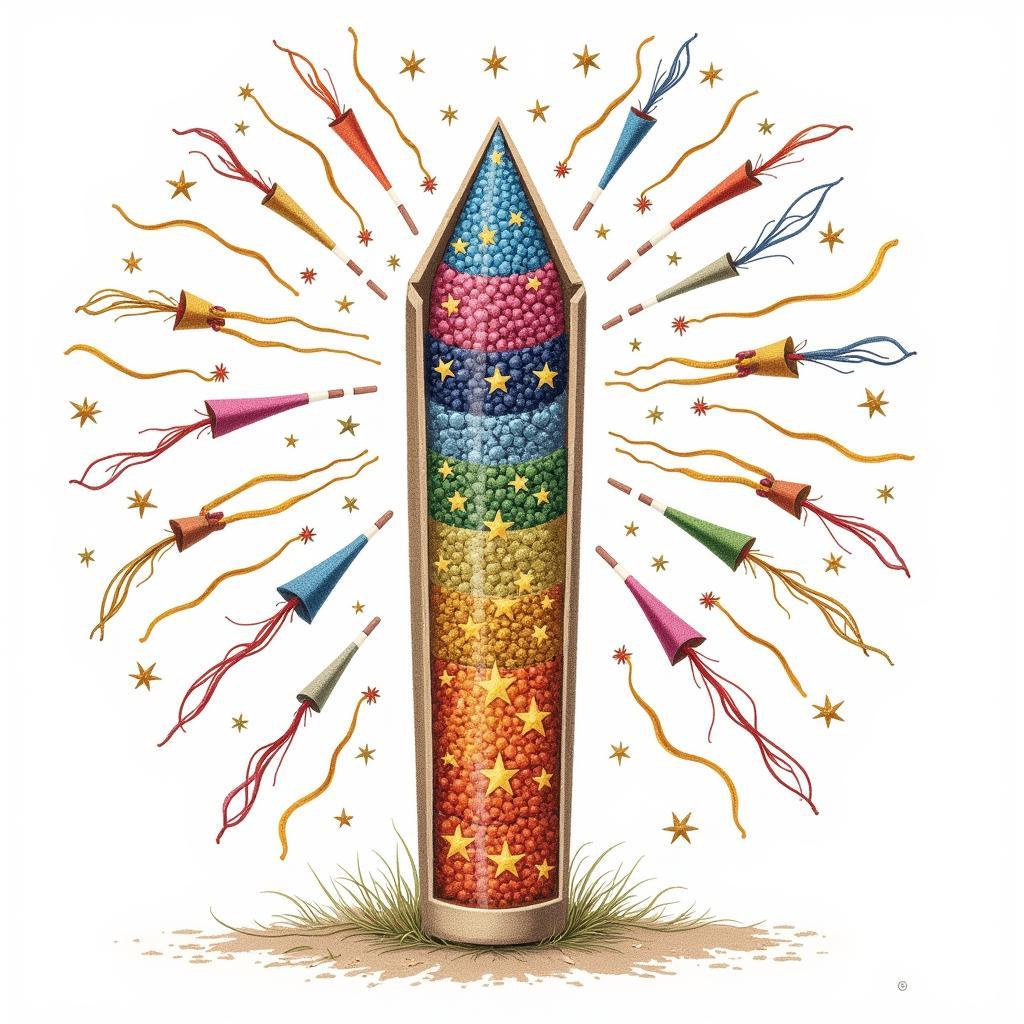Fireworks light up the night sky in a breathtaking display of vibrant colors. But what makes fireworks different colors? The magic lies in a careful blend of chemistry and artistry. Specific chemical elements, when heated, emit light at distinct wavelengths, creating the dazzling array of colors we see.
The Science Behind the Sparkle: How Chemical Elements Produce Color
The vibrant hues of fireworks result from a process called atomic emission. When heated to high temperatures during a firework explosion, the electrons in the atoms of various metallic elements absorb energy and jump to higher energy levels. As these electrons fall back to their original energy levels, they release the absorbed energy as light. Different elements emit light at specific wavelengths, corresponding to different colors. For example, strontium produces a brilliant red, barium yields a rich green, and copper creates a striking blue. This precise control over the chemical composition allows firework designers to orchestrate spectacular, multicolored displays. Similar to how to make a fire different colors, adding specific elements can alter the flames’ hue.
Common Elements and Their Corresponding Colors
Each element contributes its unique signature to the fireworks palette:
- Red: Strontium salts, such as strontium carbonate, are the primary source of rich red hues.
- Orange: Calcium chloride and calcium sulfate are responsible for vibrant orange shades.
- Yellow: Sodium nitrate produces the bright yellow commonly seen in fireworks.
- Green: Barium chloride and barium nitrate create the stunning green colors.
- Blue: Copper(I) chloride is the key ingredient for achieving deep blue shades. This is a particularly challenging color to produce, as copper compounds are less stable at high temperatures.
- Violet: A combination of strontium salts for red and copper compounds for blue results in various shades of violet.
 Firework Color Spectrum Chart Showing Different Elements and Corresponding Colors
Firework Color Spectrum Chart Showing Different Elements and Corresponding Colors
What Chemicals Make Fireworks Explode?
While metallic salts create the colors, other components are essential for the firework’s functionality. Black powder, a mixture of potassium nitrate, sulfur, and charcoal, serves as the propellant and explosive charge. It provides the initial lift charge that propels the firework into the sky and the subsequent burst charge that ignites the stars, the small pellets containing the color-producing metallic salts. The precise timing of these explosions is crucial for creating the desired effects. Much like understanding what colors make yellow orange, knowing the chemical components of fireworks is essential for comprehending their vibrant display.
How Are Different Colors Combined in Fireworks?
Firework designers carefully arrange the stars within the firework shell to create intricate patterns and multi-colored effects. By layering different color-producing compositions, they can achieve a stunning sequence of color changes. For example, a shell might contain a layer of strontium stars for red, followed by a layer of barium stars for green, and finally a layer of copper stars for blue. This meticulous arrangement allows for a dazzling transition of colors as the firework explodes. This intricate layering process has parallels with how to do 3 alternating color nails american flag theme, where precise layering creates the desired visual effect.
 Cross-Section of a Firework Shell Showing the Arrangement of Different Color Stars
Cross-Section of a Firework Shell Showing the Arrangement of Different Color Stars
The Artistry of Fireworks: Beyond the Chemistry
While the science behind firework colors is fascinating, the creation of a firework display is also an art form. Firework designers carefully consider the timing, trajectory, and arrangement of the fireworks to create a cohesive and visually stunning spectacle. They choreograph the explosions to music, building anticipation and creating moments of awe and wonder. The artistry lies in blending the scientific principles of color production with creative design and precise execution. Understanding why do fireworks have different colors goes beyond just chemistry; it’s appreciating the artistry behind the display.
“The creation of a fireworks display is a delicate balance between scientific precision and artistic expression,” says renowned pyrotechnician, Dr. Anya Sharma. “It’s about understanding the chemical reactions that produce the colors and then using that knowledge to paint the night sky with light and emotion.”
Conclusion: A Symphony of Light and Color
The vibrant colors of fireworks are a testament to the power of chemistry and the creativity of human ingenuity. By harnessing the unique properties of different elements, we can transform the night sky into a canvas of breathtaking color and light. Understanding what makes fireworks different colors allows us to appreciate the intricate science and artistry behind these dazzling displays. This knowledge enhances our enjoyment of the spectacular shows, reminding us of the fascinating interplay between scientific principles and creative expression. Much like exploring why are fireworks different colors, delving into the science and art of fireworks reveals a captivating world of color and light.
FAQ
- What is the most difficult firework color to produce?
Blue is often considered the most challenging firework color to create due to the instability of copper compounds at high temperatures. - What is the purpose of black powder in fireworks?
Black powder serves as both the propellant and explosive charge in fireworks. - How are different colors combined in a single firework?
Different color-producing stars are layered within the firework shell to create multi-colored effects. - What element creates the bright yellow color in fireworks?
Sodium nitrate is responsible for the vibrant yellow hues in fireworks. - How do fireworks explode in the air?
A timed fuse ignites the black powder lift charge, propelling the firework into the sky, followed by the burst charge that ignites the color-producing stars. - What makes fireworks sparkle?
The sparkle effect is often created by adding metal particles, such as aluminum or titanium, to the firework composition. - Can fireworks be environmentally friendly?
Research is ongoing to develop more environmentally friendly firework compositions with reduced smoke and noise pollution.
Need help with your color choices? Contact us at Phone: 0373298888, Email: [email protected] or visit us at 86 Cau Giay, Hanoi. Our customer service team is available 24/7.

